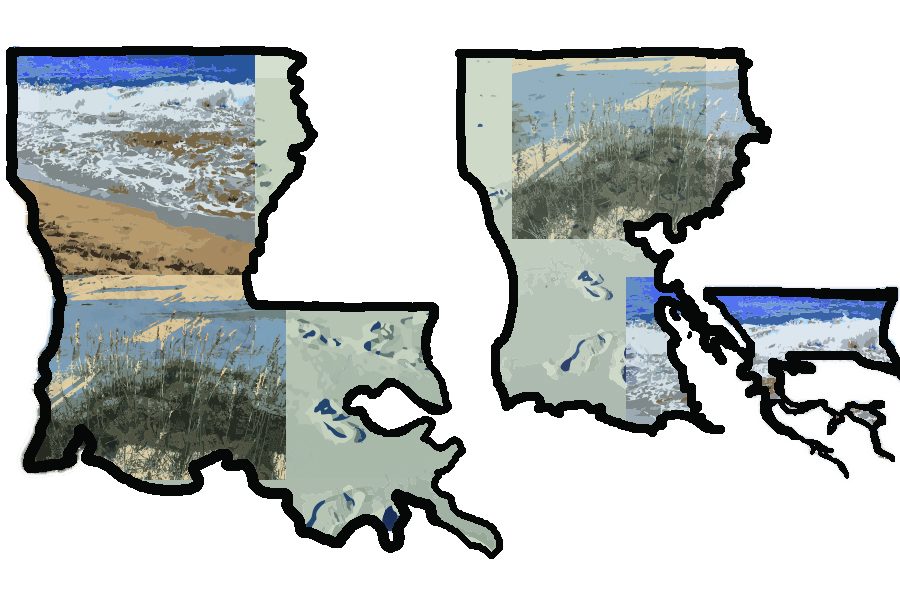Ask Views: What is the best way to approach coastal restoration in Louisiana?
The following are opinions columns and do not reflect the views of The Tulane Hullabaloo.

Daniel Horowitz, Views Editor
We live in a sinking state. Experts have done what they can to attempt to build and restore land on the coast to compensate for the land being lost, but the land restoration is not being completed fast enough to match the rate of erosion. What we can do is try to restore and protect natural areas of land that help protect coastal cities from stormwater flooding. If cities can be resilient to stormwater and other potential sources of flooding, then we can buy time while trying to create new ways to restore the coast. Meanwhile, we should not give up current efforts to restore coastal areas. Regardless of how we do it, learning from the successes and failures of current methods is what will inspire new and innovative methods that can give us hope for the future of Louisiana.
Daniel is a senior at Newcomb-Tulane College. He can be reached at dhorowi@tulane.edu.

Quinn Burke, Associate Views Editor
Before any talk of reclamation, rebuilding or restoration occurs, one fact needs to be acknowledged: our system is not sustainable. The world has long operated under the idea of infinite growth being possible without acknowledging the finite world we inhabit. Now we have to face the ramifications of our growth. New Orleans and Louisiana as a whole will be some of the areas most affected. Rising sea levels will displace over half a million people, and Louisiana may lose up to 10 percent of its GDP. Though efforts to reclaim land and restore swampland are admirable, it’s a losing battle. Even if a surefire way to reclaim land was developed, it would be too little. Human consumption outmatches the planet’s capabilities, and this same situation will occur again. Louisiana needs to recognize this fact and find a new way to work its economy to fit a new climate. Whether we like it or not, change is coming, and New Orleans must adapt.
Quinn is a freshman at Newcomb-Tulane College. He can be reached at qburke@tulane.edu.

Shea Dobson, Staff Writer
Studies have shown that coastal restoration throughout the Gulf Coast is highly unlikely to keep up with land loss throughout the region. Despite that, billions of dollars are being poured into coastal restoration projects, which are in all effects futile. Louisiana’s land loss is equal to that of a standard football field every 100 minutes, but rather than take measures to slow land loss, our legislators are simply dumping more land on and seeing what sticks. Coastal restoration provides the barest of reprieve to our natural coastal wetlands. Once the added land is gone, they are right back on the chopping block. If state legislators really want to fix the problem, they need to start by taking precautionary measures for the land we haven’t lost yet.
Shea is a sophomore at Newcomb-Tulane College. He can be reached at sdobson@tulane.edu.

Madeline Ninno, Staff Writer
After a study by researchers at Tulane University revealed that Louisiana’s restoration projects will not be able to build land fast enough to keep up with the rate of wetland loss, communities must begin focusing on methods to deal with the inevitability of rising seawaters. While the state should continue funding restoration projects, it should also update building codes and help residents of flood-prone areas reduce the damage caused by flooding through the construction of flood walls and planting rain gardens. The reconstruction of the Lower Ninth Ward shows how neighborhoods can be redesigned and rebuilt to be more resistant to flooding. Louisiana must also prepare for the consequences of more damaging floods, ensuring that it has the manpower and resources to help those impacted by extreme weather.
Madeline is a sophomore at Newcomb-Tulane College. She can be reached at mninno@tulane.edu.
Your donation will support the student journalists of Tulane University. Your contribution will allow us to purchase equipment and cover our annual website hosting costs.




Chris McLindon • Apr 19, 2018 at 8:06 am
The Chamberlin et al study compares the average rates of delta growth measured over centuries to the short term episodic rates of land loss measured over decades. Even the relatively short term rate of a football field of land loss per 100 minutes is an average over several decades. A study of subsidence and land loss rates by Kolker et al, 2011 showed a “tightly coupled” relationship in which peak values of both subsidence and wetlands loss occurred between the 1960s and the 1980s. Both rates have been continually declining since then. The 2017 USGS SIM 3381 Land Area Change Map showed that observed data of total wetlands area increased by over 600 square kilometers between 2008 and 2016. This is consistent with data from with CRMS network to be presented by CPRA at the upcoming State of the Coast Conference showing that “over the last decade, wetland surface elevation trajectories have been positive at 75% of [CRMS] sites, including those in coastal areas near the Mississippi River delta”.
The “State of Emergency” approach to coastal sustainability is fundamentally based on ignoring data. This approach is being primarily used to promote the very large (and expensive) projects that will attempt to reverse historical land loss in subsidence hot spots. It misses a great opportunity to understand the natural processes by which stable marsh platforms sustain themselves through sediment redistribution, and to shift our emphasis to working with nature instead of trying to bully it into submission.